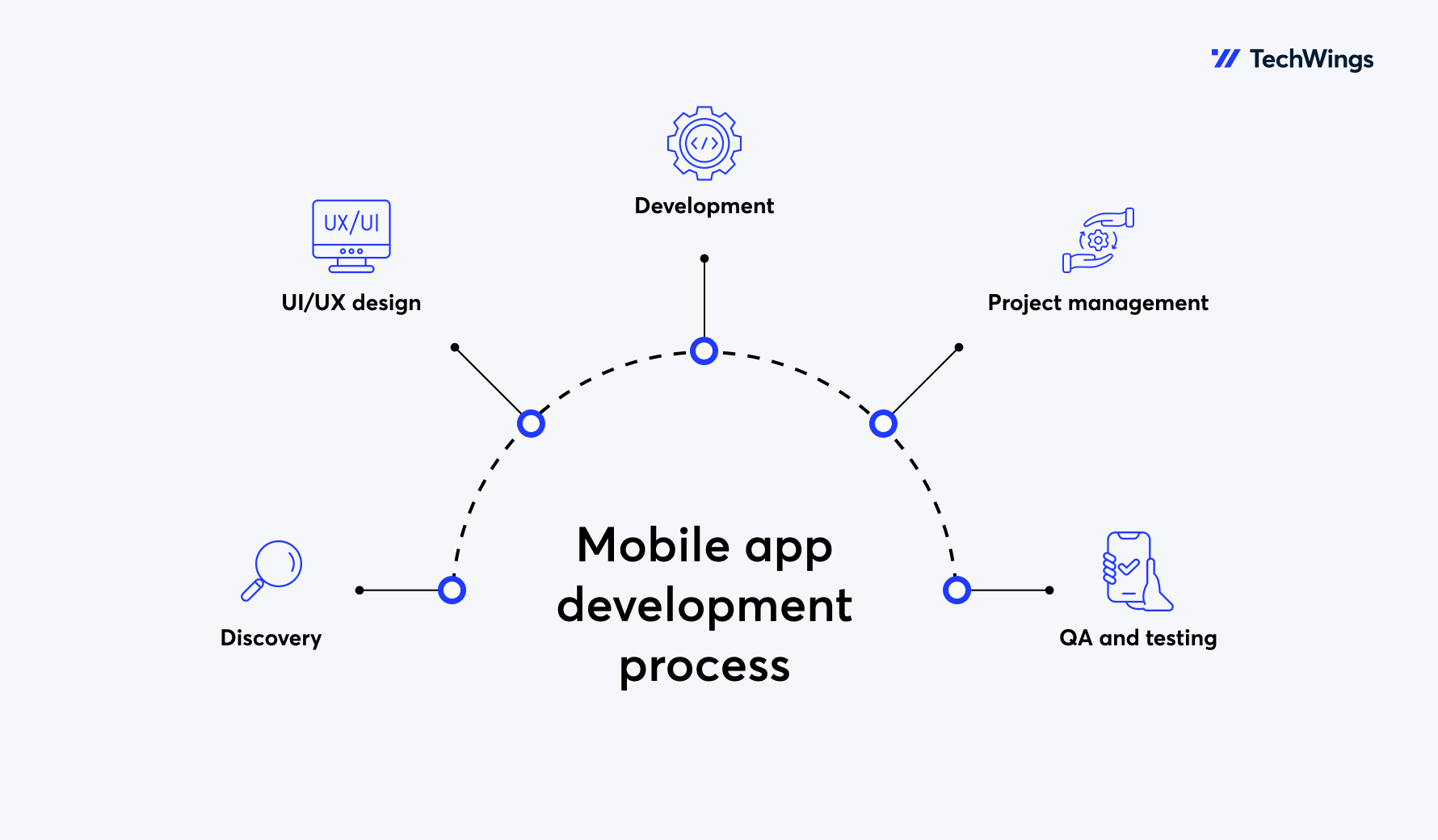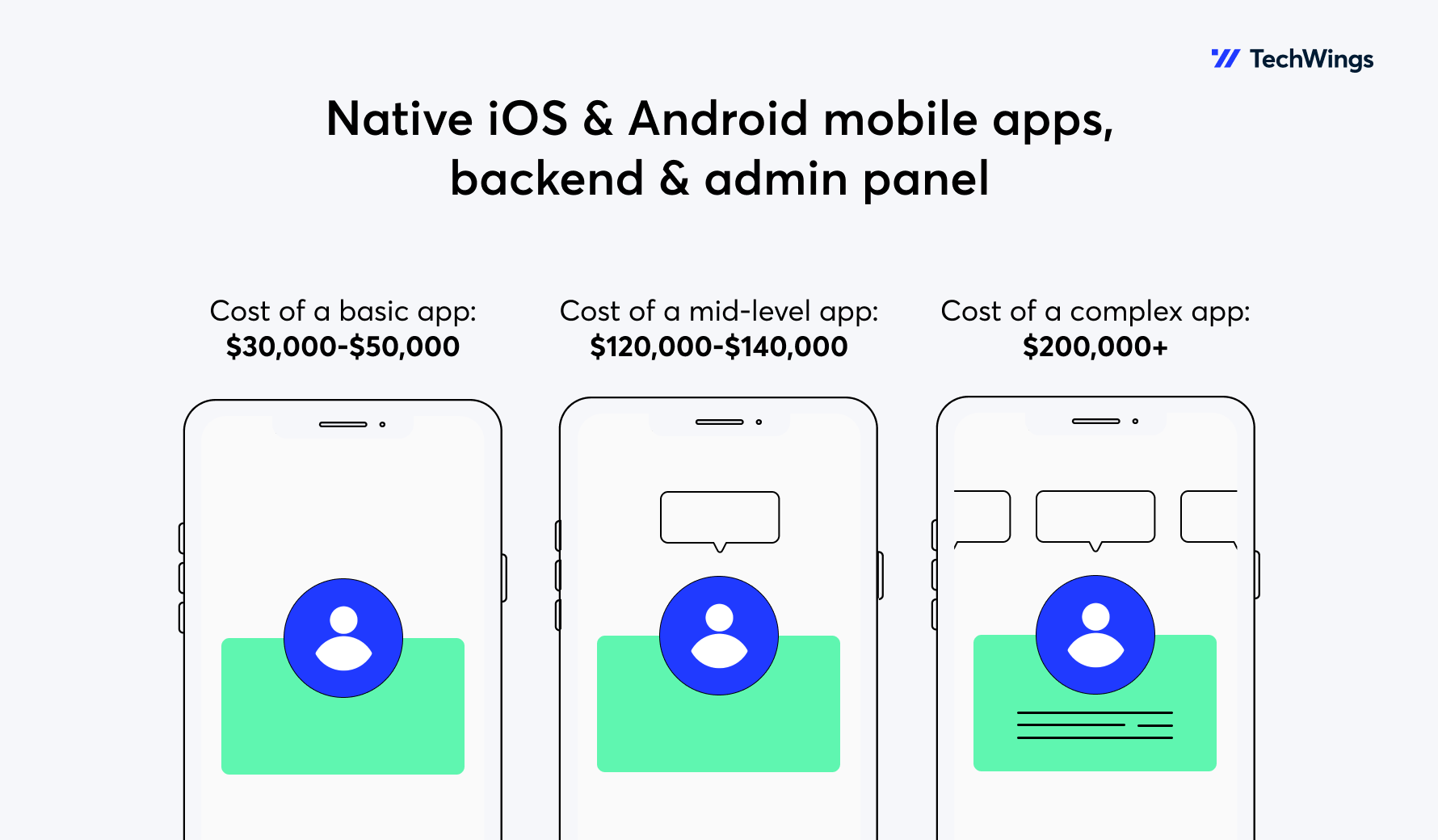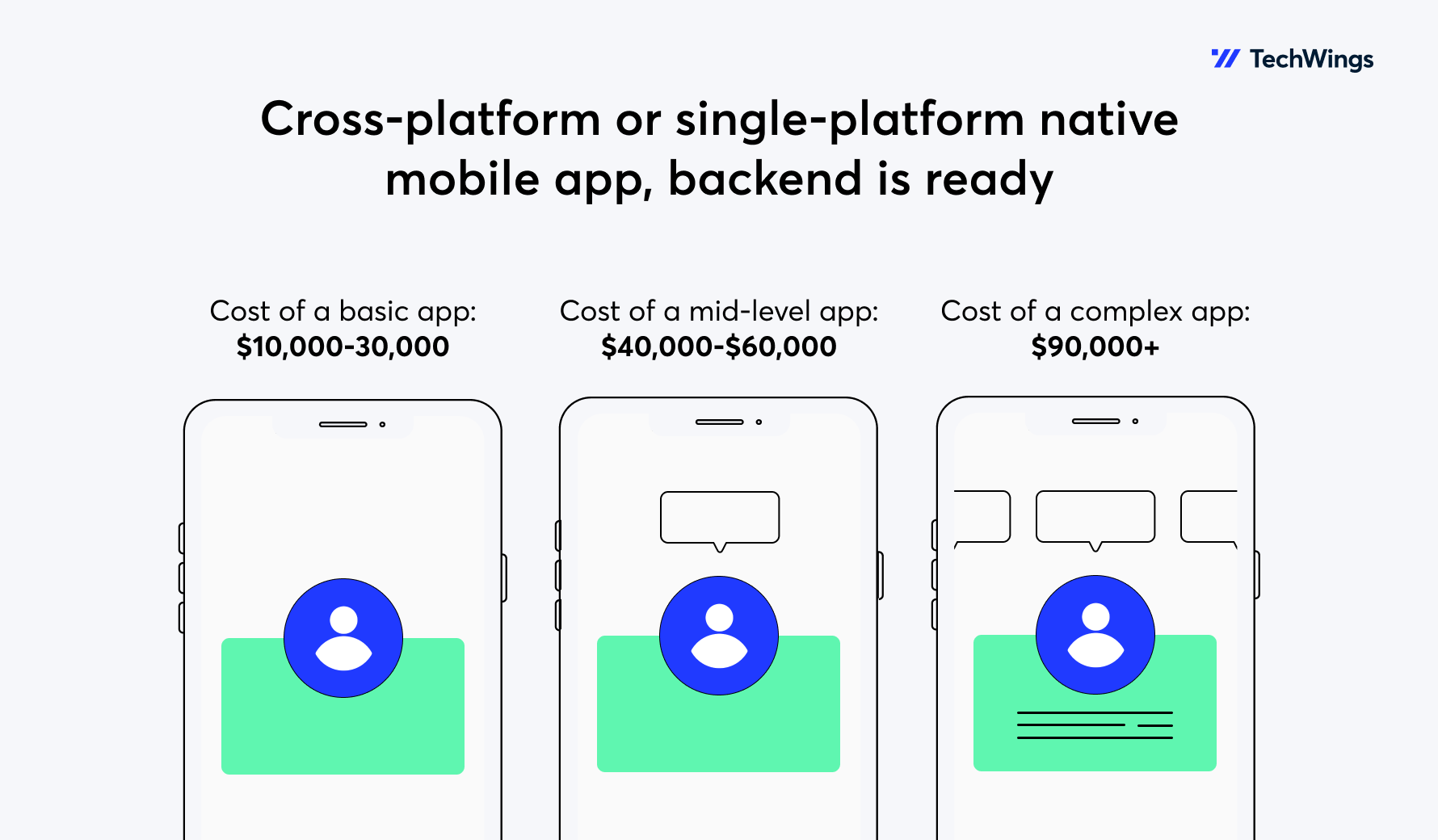If you’ve decided to tap into the prominent business potential of launching a mobile app, one of your first questions might be: How much does it cost to develop a mobile application?
Well, that’s quite reasonable since you need to allocate the budget and ensure the end product can bring the desired ROI.
Delivering hundreds of digital products of various types and complexity, TechWings has obtained in-depth fundamental knowledge of the development times and costs involved.
Thus, we’ve prepared this comprehensive guide to help you understand mobile app development costs in detail.
What does the cost of developing an app involve?
Building a mobile app is a complex process involving much more work than just writing the code. Different aspects of the app development process require different roles and skills you should expect to pay for. Let’s take a closer look at these.
Discovery
Most projects that are developed from scratch require the development of a business idea, features prioritization, as well as the creation or revision of technical and business documentation for the development team.
In our company, we handle this process simultaneously with the UX/UI design of the application. While the business analyst collaborates with the designer on the business specification, the development team works on the technical specification.
After this stage, we form a comprehensive vision of the project. The business logic, screens, and visual aspects of the application are developed and approved by the customer. The development team gets a clear understanding of the appearance of each screen and how each feature should function.
Development of an application
The code and app architecture form the primary stages in developing a mobile application, comprising most of the costs. This phase consists of three core components:
Backend: The backend phase of app development plays a crucial role in building the foundation of the application. One of the key aspects is the construction of the database, where data is stored and organized efficiently. The backend team also focuses on developing server-side objects that handle various operations, such as data retrieval, processing, and storage.
Business logic: The integration layer known as the business logic forms a vital bridge between the backend APIs and the mobile application. It enables the coordination and synchronization of data and processes, ensuring that the app functions seamlessly. The business logic layer handles complex operations, calculations, and decision-making processes required to provide the desired functionality to the end users.
Frontend: The frontend aspect of app development is responsible for creating the visual elements and user interface components that users directly interact with. This includes designing and implementing screens, layouts, transitions, animations, and other visual elements that enhance the user experience.
Project management
To ensure flawless mobile implementation on time and within budget, a dedicated project manager (PM) oversees the project from the discovery phase to release. The PM’s primary responsibilities include giving assignments, identifying resource needs, tracking core milestones, managing the budget, and coordinating efficient communication between all stakeholders.
QA and testing
Quality assurance (QA) and testing are crucial to ensure the application is usable, stable, and secure. Of course, this requires a team of specialists and multiple working hours, adding much to the total mobile app development cost.
QA and testing procedures involve:
UX testing: This includes checking the visuals, workflow, and interactivity of your app, making sure it has a consistent style, fonts, color scheme, icon design, and navigation.
Functional testing: Functional testing helps ensure that consumers can use your app’s features and functionality without any issues. It’s often broken down into system testing (the app as a whole) and unit testing (individual functions of the app).
Performance testing: This involves measuring the app’s performance, i.e., how well it responds to user requests, how fast the app’s screens load, and how much it affects the device’s battery level and storage capacity. Testing should include the conditions when usage spikes.
Device and platform testing: Unlike testing web applications, which typically involves testing an app on a single browser, a mobile app must be launched on multiple mobile devices, emulators, and platforms, if applicable, to ensure it runs smoothly wherever it’s supposed to.
Security testing: Security testing is the process of making the app more resistant to security issues by identifying potential vulnerabilities in the code.
How much does it cost to develop a mobile application?
We confidently assert that analyzing the complexity of a mobile app is the best approach to determining its development cost.
Based on our experience, we can provide approximate figures to give you an idea of the costs associated with developing a native app for iOS and Android platforms, which includes a custom backend and a full-featured admin panel:
Basic app: $30,000 - $50,000
Medium-complexity app: $120,000 - $140,000
Complex app: $200,000+
Furthermore, these numbers can change significantly if you choose to focus on a single platform and already have the backend implemented:
Basic app: $10,000 - $30,000
Medium-complexity app: $40,000 - $60,000
Complex app: $90,000+
Curious? Continue reading.
The average cost of making an app
Let's take a detailed look at how we estimate the cost of mobile app development for both iOS and Android platforms. If you choose a cross-platform approach or start from a single platform on the MVP stage, you can simply exclude one of the platforms listed below.
Since TechWings offers turnkey mobile app development, we provide an honest and comprehensive cost breakdown that also includes the backend and frontend for the admin panel. If you already have them implemented, use a CRM system, etc., just omit unnecessary things.
Basic apps
A basic native mobile app typically ranges from $30,000 to $50,000, with an effort going between 1-3 man-months. This cost includes a set of basic features with elementary business logic, no more than 5 screens, and a simple user interface without any custom components. Note that an admin panel is not included in this cost.
Specialist | Hours | Rate | Cost |
|---|---|---|---|
UX/UI Designer | 80 | $45/h | $3.600 |
Business Analyst | 40 | $50/h | $2,000 |
Project Manager | 80 | $45/h | $3,600 |
Android Developer | 240 | $50/h | $12,000 |
iOS Developer | 240 | $50/h | $12,000 |
Backend Developer | 120 | $45/h | $6,000 |
QA Engineer | 120 | $35/h | $4,200 |
Total | $43,400 |
Medium-complexity apps
A medium-complexity native app for both platforms typically costs between $120,000 and $140,000, with an effort ranging from 4-6 man-months. This cost includes implementing sophisticated features with intermediate business logic, 6-15 screens, a few custom UI elements, and an admin panel.
Specialist | Hours | Rate | Cost |
|---|---|---|---|
UX/UI Designer | 160 | $45/h | $7,200 |
Business Analyst | 120 | $50/h | $6,000 |
Project Manager | 238 | $45/h | $10,710 |
Android Developer | 640 | $50/h | $32,000 |
iOS Developer | 640 | $50/h | $32,000 |
Backend Developer | 320 | $50/h | $16,000 |
Frontend Developer | 240 | $50/h | $12,000 |
QA Engineer | 380 | $35/h | $13,300 |
Total | $129,210 |
Since applications of medium complexity are the most common projects, we will also use them as an example to demonstrate the cost in the case of cross-platform development or development for a single platform:
Specialist | Hours | Rate | Cost |
|---|---|---|---|
UX/UI Designer | 160 | $45/h | $7,200 |
Business Analyst | 120 | $50/h | $6,000 |
Project Manager | 158 | $45/h | $7,110 |
Mobile Developer | 640 | $50/h | $32,000 |
Backend Developer | 320 | $50/h | $16,000 |
Frontend Developer | 240 | $50/h | $12,000 |
QA Engineer | 220 | $35/h | $7,700 |
Total | $88,010 |
We will also consider scenarios where the backend is already implemented:
Specialist | Hours | Rate | Cost |
|---|---|---|---|
UX/UI Designer | 160 | $45/h | $7,200 |
Business Analyst | 120 | $50/h | $6,000 |
Project Manager | 96 | $45/h | $4,320 |
Mobile Developer | 640 | $50/h | $32,000 |
QA Engineer | 160 | $35/h | $5,600 |
Total | $55,120 |
As you can see, the difference is significant.
Complex apps
You should expect to pay over $200,000 for a complex native app with an effort exceeding 6 man-months. This app runs on iOS and Android and incorporates numerous complex features with advanced business logic, over 15 screens, and custom UI elements.
This level of complexity necessitates intricate architecture, integrations, and addressing high-security needs. Additionally, the cost includes the development of a full-featured admin web application.
Specialist | Hours | Rate | Cost |
|---|---|---|---|
UX/UI Designer | 240 | $45/h | $10,800 |
Business Analyst | 200 | $50/h | $10,000 |
Project Manager | 388 | $45/h | $17,460 |
Android Developer | 960 | $50/h | $48,000 |
iOS Developer | 960 | $50/h | $48,000 |
Backend Developer | 640 | $50/h | $32,000 |
Frontend Developer | 480 | $50/h | $24,000 |
QA Engineer | 800 | $35/h | $21,000 |
Total | $211,260 |
Summary
Keep in mind that the above calculations are approximate and provided for both platforms and include backend and frontend development services. At TechWings, we deliver full-cycle Product Delivery services, planning and building your app from A to Z.
The final estimate for your application may vary, as each project is unique. Ultimately, it depends on the desired application's functionality and specific business requirements.
It is also important to reiterate that you can significantly reduce development costs by choosing cross-platform development using React Native or Flutter or focusing on only one platform. However, it is crucial to consider that cross-platform development has certain limitations and may not be suitable if the application relies on low-level hardware capabilities specific to a platform.
Factors affecting mobile app development cost
As discussed earlier, one of the major factors affecting mobile app development costs is time. The total price is calculated based on time multiplied by the hourly rates of the specialists involved.
However, while some apps take up to two months to hit the market and others can require nine months or even more, it makes sense to take a more detailed look at other factors affecting the development time and, ultimately, the cost of developing an app.
Targeted platforms
When planning a mobile app, one crucial thing to sort out is the platform you want your product to run on — iOS, Android, or both. This decision will directly affect the price of developing an app.
Suppose you need a native application designed for a single operating system. In that case, the cost will depend on your app functionality, the design complexity, etc., since the rates for iOS and Android development are pretty much the same.
However, if you want to hit both Google Play and the App Store, the following information can help you save considerable costs and time.
There are two key approaches to mobile app development: native and cross-platform. Let’s look at them from the app development costs perspective.
Native app development
Native app development refers to building a mobile app for a specific platform, either iOS or Android. It means that if you decide to target both audiences, you’ll have to create two separate apps, multiplying the final app development cost by two. The same goes for new features — you’ll need to devote twice the time and costs when introducing them.
Despite this, many businesses choose native development since native apps are faster, boast high performance, and use custom UI components, making the app feel like an integral part of the device and thus boosting user experience.
Cross-platform app development
Cross-platform mobile app development allows you to build one app to target both Android and iOS using the same codebase. What’s more, your app will also be able to run seamlessly on the web. While cross-platform development helps save costs and time, these apps sometimes deliver lower performance than native apps and tend to look and feel less native.
Still, if you consider cross-platform development due to its cost and time efficiency but want to minimize its weaknesses, we recommend choosing Flutter to build your mobile application. The most popular tool for cross-platform development, Flutter is equipped with features that ensure high speed, outstanding performance, and, most importantly, UIs that barely differ from what native apps offer.
Hybrid app development
In this article, we focus on providing examples of native and cross-platform development, as a hybrid, PWA, and other similar approaches are more associated with web development. When it comes to developing mobile applications, here at TechWings, we recommend our clients go native or, more frequently, consider using Flutter or React Native to reduce costs.
Features and functionality
Needless to say, the complexity of features directly impacts the amount of time the project team needs to invest in your app. While certain functions can be relatively simple to implement, others require more time and effort.
For instance, functionalities such as password storage, password recovery, social sign-in, push notifications, social sharing, commenting, in-app purchases, location-based services, and integration of device features can have a significant impact on the final price tag.
Geographic location of the team
The final price of app development will depend on the hourly rates of the team, which differ globally. Let’s explore the average hourly rates of development team members in different regions (according to the Accelerance report):
Specialist | North America | Latin America | Central Europe | South Asia |
|---|---|---|---|---|
Architect | $139-$182 | $72-$96 | $71-$95 | $58-$71 |
Senior Developer | $143-$172 | $65-$82 | $68-$76 | $41-$49 |
Middle Developer | $119-$144 | $53-$66 | $47-$65 | $35-$41 |
Junior Developer | $75-$91 | $41-$53 | $35-$53 | $25-$36 |
Senior QA Engineer | $117-$139 | $53-$66 | $47-$61 | $34-$37 |
Middle QA Engineer | $104-$126 | $42-$59 | $41-$59 | $29-$32 |
Junior QA Engineer | $62-$78 | $34-$52 | $26-$44 | $24-$29 |
UX/UI Designer | $79-$100 | $48-$75 | $53-$71 | $38-$43 |
Business Analyst | $109-$154 | $56-$68 | $57-$81 | $40-$61 |
Project Manager | $121-$153 | $54-$79 | $61-$74 | $44-$50 |
DevOps | $114-$148 | $59-$82 | $62-$79 | $29-$44 |
As you can see, the hourly rates of software developers in countries such as the UK and the US are considerably higher than in Asian or Eastern European countries that are becoming increasingly popular as outsourcing destinations.
Thanks to our remote-first approach and distributed cross-functional team. TechWings, as a European company, can still provide a significantly better price-to-quality ratio in both the EU and US markets.
Local team vs. outsourcing
Hiring a local app development team will enhance communication efficiency, as it allows for face-to-face interaction and easier conveyance of requirements. Additionally, you have the opportunity to meet the team in person before finalizing the contract. However, it is important to note that partnering with a local team tends to be more expensive, and the talent pool is limited to the specific location.
On the other hand, outsourcing app development offers significantly lower costs without compromising on quality. Moreover, with the availability of video conferencing and modern collaboration tools, communication can be smooth and effective. When you decide to outsource your app development, you gain access to a vast talent pool, which includes developers with rare expertise and skills.
The primary challenge associated with outsourcing is the potential difference in time zones. However, this is only sometimes an issue. For example, if you are on the US East Coast and your team is located in Poland, there will still be overlapping working hours. When it is 9 am in NYC, it is 15 pm in Warsaw.
Team setup
Of course, your app development cost will depend on the size of the team, which will be based on your needs and goals.
A development team usually consists of Product Owner from the client’s side, Business Analyst, Project Manager (Scrum Master), QA Engineer, UX/ UI Designer, 2x Android developer, and 2x iOS developer on average.
Depending on the size of the application, we recommend assigning 1 to 3 developers for each platform. For basic applications, 1 developer is typically sufficient, while complex applications may require up to 3 developers to handle the implementation of intricate tasks.
Get a custom quote for your app
As you can see, the cost of mobile app development depends on various factors, and it is challenging to determine the final price tag without considering all of them.
At TechWings, we can analyze your project requirements and provide you with a customized mobile app development cost estimate. Feel free to contact us for a personalized quote and take a step closer to turning your dream app into reality!




